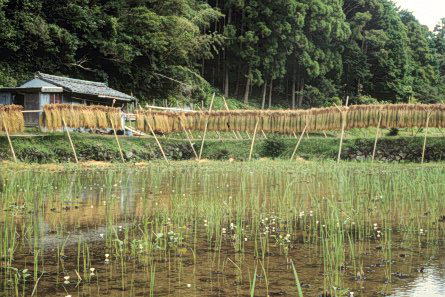Welcome to Home Page of Professor Emeritus Hirofumi Yamaguchi (Biodiversity,
Biocultural aspect of plants), Osaka Prefecture University.
 This paddy is absent due to uncultivation.
This paddy is absent due to uncultivation.
A Landscape of Traditional Paddy in Kii Oshima island in Southern Honshu
of Japan in 1999.

Rich plant diversity in Himalayan Highlands in Yunnan, China. There are
numerous flowers and landraces of cultivated plants near dwellers' hamlets.
RESEARCH SUBJECT:
My research major is plant biodiversity at past, present and future in
the levels of gene, individual, population, species, community and landscape
analyzed by bioscience technology for human beter life and sustainable
utilization of plant genetic resources and for development of new crops
with harmonies of living organisms.
RECENT PUBLICATIONS:Excluded Japanese Articles
and Books (see Japanese Homepage)
Biodiversity of Economic Plant and Wild Genetic
Resources
●L. Guo, .... H.Yamaguchi, .... LJ Fan 2017. Echinochloa crus-galli genome analysis provides insight into its adaptation and invasiveness
as a weed. Nature Communications 8:1031 DOI: 10.1038/s41467-017-01067-5
●K. Yamane, Y. Sugiyama, YX. Lu, Na Lu, K. Tanno, E. Kimura, and H. Yamaguchi
2016. Genetic differentiation, molecular phylogenetic analysis, and ethno-botanical
study of Eutrema japonicum and E. tenue in Japan and E. yunnanense in China. Horticulture Journal 85 (1): 46-54.
●R. Miyaura, T. Ohno, H. Maenaka, K. Sumiartha, H. Yamaguchi 2015. A particular
silhouette of human-influenced coconut trees in Hindu Bali, Indonesia:
An ethnobotanical field note. Ethnobotany Research & Applications 14:405-421.
●F. Javadi, Ye Tun Tun, M. Kawase, KY. Guan, H. Yamaguchi 2011. Molecular
phylogeny of the subgenus Ceratotropis (genus Vigna, Leguminosae) reveals three eco-geographical groups and Late Pliocene–Pleistocene diversification: evidence from four plastid DNA region sequences. Annals of Botany 108:367-380.DOI:10.1093/aob/mcr141
●D. Aoki and H. Yamaguchi 2009. Oryza sh4 gene homologue represents homoeologous genomic copies in polyploid Echinochloa. Weed Biology and Management 9:225-233.
●E. Tanesaka, T. Ohno, and H. Yamaguchi 2010. Species diversity of the genus Echinochloa (Poaceae), native to eastern Australia: a focus on their habitat and the
threat of exotic species. J. Crop Res. 55:13-17
●D. Aoki and H. Yamaguchi 2008. Genetic relationships among Echinochloa crus-galli and E. oryzicola accessions inferred from ITS and chloroplast DNA sequences. Weed Biology
and Management 8: 233-242.
●Ye Tun Tun and H. Yamaguchi 2008. Sequence variation of four chloroplast
non-coding regions among wild, weedy and cultivated Vigna angularis accessions.
Breeding Science 58: 325-330.
●Ye Tun Tun and H. Yamaguchi 2007. Phylogenetic relationship of wild and
cultivated Vigna (subgenus Ceratotropis, Fabaceae) from Myanmar based on sequence variations in non-coding regions
of trnT-F. Breeding Science 57: 271-280.
●F. Javadi, M.F. Wojciechowski, and H. Yamaguchi 2007. Geographical diversification
of the genus Cicer inferred from molecular phylogenetic analyses of chloroplast and nuclear
DNA sequences. Bot. J. Linn. Soc. 154:175-186.
●K. Yasuda and H. Yamaguchi 2005. Genetic diversity of vegetable water
pepper (Persicaria hydropiper (L.) Spach as revealed by RAPD markers. Breeding Science 55(1):7-14.
●A. Yano, K. Yasuda, and H. Yamaguchi 2004. A test for molecular identification
of Japanese archaeological beans and phylogenetic relationship of wild
and cultivated species of subgenus Ceratotropis (genus Vigna, Papilionaceae) using sequence variation in two non-coding regions of
the trnL and trnF genes. Econ. Bot. 58 (suppl.):135-146.
●F. Javadi and H. Yamaguchi 2004. Interspecific relationships of the Genus
Cicer L. (Fabaceae) based on trnT-F sequences. Theor. Appl. Genet. 109 (2):317-322 (DOI:10.1007/s 0012-004-1622.09).
●F. Javadi and H. Yamaguchi 2004. A note on seed coat and plumule morphological
variation in the genus Cicer L. (Fabaceae). Sci. Rep. Grad. Sch. Agric. and Biol. Sci. Osaka Pref. Univ. 56:7-16.
●F. Javadi and H. Yamaguchi 2004. RAPD and seed coat morphology variation
in annual and perennial species of the genus Cicer L. Genetic Resources and Crop Evolution
51 (7): 783-794.
●Y. Michishita and H. Yamaguchi 2003. Unique forms and millets in East
Asian annual Echinochloa. Proc. 19 APWSS Conf. 215-220.
●M. Mimura, K. Yasuda and H. Yamaguchi 2000. RAPD variation in wild, weedy
and cultivated Azuki beans in Asia. Genetic Resources and Crop Evolution
47:603-610.
●S. Kato, H. Yamaguchi, Y. Shimamoto, and T. Mikami 2000. The chloroplast genomes of Azuki bean and its close relatives: A deletion mutation found in weed Azuki bean. Hereditas 132:43-48.
●H. Yamaguchi and M. Okamoto 1997. Traditional seed production in landraces
of Daikon (Raphanus sativus L.) in Kyushu, Japan. Euphytica 95:141-147.
●Y. Sugimura, M. Itano, C.D. Salud, K. Otusji, and H. Yamaguchi 1997. Biometric analysis on diversity of coconut palm: Cultivar classification by botanical and agronomical traits. Euphytica 98:29-35.
●H. Yamaguchi,Y. Takamatsu, T. Fujita, and A. Soejima 1997. Pedigree of
edible lily cultivars assumed by chloroplast DNA polymorphism. Acta Phytotax.
Geobot. 47:183-193.
●K. Yasuda and H. Yamaguchi 1996. Phylogenetic analysis of the subgenus
Ceratotropis (genus Vigna) and an assumption of the progenitor of Azuki bean using isozyme variation.
Breeding Science 46:337-342.
●H. Yamaguchi and S. Umemoto 1996. Wild relatives of domesticated plants as genetic resources in disturbed environments in temperate East Asia: A review. Applied Biological Science 2(1):1-16.
Biosystematics and Population Ecology of Weeds and Ruderals.
●H. Yamaguchi 2007. A hidden variety of barnyard grass (Echinochloa crus-galli var. riukiuensis Ohwi) found in Okinawa, Japan. Proc. 21st APWSS Conf. 643-646.
●I.A. Adilah, H. Yamaguchi, B. Baki and K. Yamane 2007. Sequence variation
in the gene affecting the grain shattering traits in weedy rice (Oryza sativa L. f. spontanea) in Asia. Proc. 21st APWSS Conf. 4-7.
● T. Ohno, H. Maenaka and H. Yamaguchi 2007. Bamboos as a weed at urban
fringe in Japan. Proc. 21st APWSS Conf. 634-638.
●H. Yamaguchi, A. Utano, K. Yasuda, A. Yano, and A. Soejima 2005. A molecular
phylogeny of wild and cultivated Echinochloa in East Asia inferred fromnNon-coding region sequences of trnT-L-F. Weed
Biology and Management 5(4): 210-218.
●K. Yasuda, A. Yano, Y. Nakayama, and H. Yamaguchi 2002. Molecular identification of Echinochloa oryzicola and E. crus-galli using a polymerase chain reaction-Restriction Fragment Length Polymorphism
technique. Weed Biology and Management 2: 11-17.
Environmental Impacts of Genetically Manipulated
and Alien Plants as Biohazzads
●Y. Nakayama and H. Yamaguchi 2002. Natural hybridization in wild soybean
(Glycine max ssp. soja) by pollen flow from cultivated soybean (Glycine max ssp. max) in a designed population. Weed Biology and Management 2: 25-30.
●H. Watanabe and H. Yamaguchi 1999. Diffusion of herbicide resistant gene
by pollen flow in weeds, In 'Biological Invasions of Ecosystem by Pest
and Beneficial Organisms' NIAES.
●H. Yamaguchi, S. Nakai, and H. Watanabe 1996. Diffusion of paraquat resistant
gene by pollen flow in the natural and designed populations in Erigeron philadelphicus L. Weed Res., Japan 41:189-196.
In situ Conservation of Endangered Plants, and their
Restoration
●T. Ishii, Y. Nakayama, M. Kobayashi, and H. Yamaguchi 2004. A note on
the genetic diversity of the vulnerable aquatic macrophyte Sparganium erectum and its congeners (Sparganiaceae) in rural wetland in Japan. Weed Biology
and Management 4(4): 230-234
Biodiversity in Traditional Agricultural Environments
●S. Umemoto, Dung Tien Nguen, and H. Yamaguchi 1999. Traditional devices
for threshing rice grains in Northeastern Vietnam. Sci. Rep. Coll. Agric.,
Osaka Pref. Univ. 51:39-41.
●M. Masanaga, S. Umemoto, and H. Yamaguchi 1998. Traditional devices for threshing rice seeds in Yun-Gui Highland, China. Bull. Osaka Pref. Univ. Ser. B. 50:1-10.
 This paddy is absent due to uncultivation.
This paddy is absent due to uncultivation. This paddy is absent due to uncultivation.
This paddy is absent due to uncultivation.